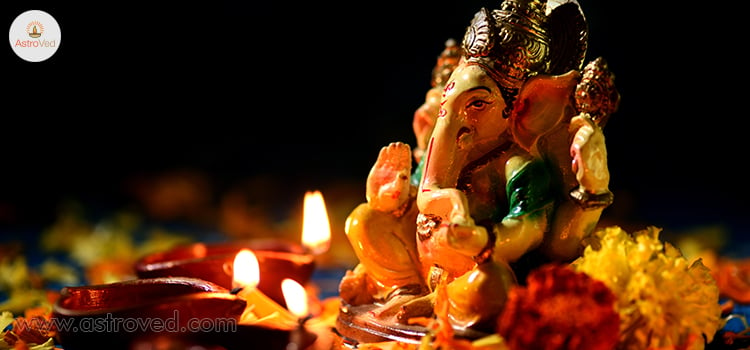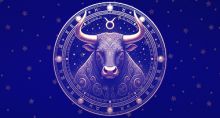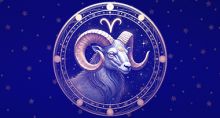History of Ganesha Chaturthi
Ganesha Chaturthi is one of the important Hindu festivals to celebrate the birth of Lord Ganesha. The festival is ardently celebrated all over India, especially in the states of Maharashtra and Goa. Ganesha Chaturthi, also known as Vinayaka Chaturthi is observed on the Shukla Paksha Chaturthi (4th Waxing Moon) in the month of August–September.  Lord Ganesha has a unique physique with distinct features that makes him special and stand out from other Gods. He is characterized by an elephant head on a human body with a pot belly and a plump body. He is depicted with four hands, holding a trident, goad, lotus and rosary or bowl of modakas (dumplings), respectively.
Lord Ganesha has a unique physique with distinct features that makes him special and stand out from other Gods. He is characterized by an elephant head on a human body with a pot belly and a plump body. He is depicted with four hands, holding a trident, goad, lotus and rosary or bowl of modakas (dumplings), respectively.
Legend behind Ganesha’s Birth
According to Hindu mythology, Goddess Parvati created Ganesha out of the turmeric powder applied on her body before bath. She made a child figure out of it and breathed life into him and asked him to be her gatekeeper and not to allow anyone until she took bath. During this time, Lord Shiva, her consort came to visit her. The young lad, unknowing of the fact who he is, stopped Lord Shiva at the entrance.
Infuriated Shiva fought with the boy and beheaded him. When Goddess arrived, she was extremely upset to see her son dead and headless. In order to pacify his wife, Shiva ordered one of his Ganas (army person) to bring the head of the first thing he sees sleeping facing its head towards north. The head of an elephant found in this posture, was cut and brought by the Gana, which was placed on Ganesha’s body. He was resurrected by Lord Shiva. Goddess Parvati was elated to see her son back to life. This resurrection of Ganesha with an elephant’s head is celebrated as Ganesha Chaturthi. On the same day, Lord Shiva blessed him as the leader of his Ganas (hence the name ‘Ganapati’) and blessed him as the bestower of good fortune, wisdom and prosperity.
History of Ganesha Chaturthi
According to historian Shri Rajwade, the earliest celebration of Ganesha Chaturthi dates back to the reigns of Satavahana, Rashtrakuta and Chalukya dynasties. According to historical findings, Ganesha Chaturthi celebration was initiated during the rule of the great Maratha King Chatrapati Shivaji, as a tool to promote culture, oneness and nationalism. Later, during the Peshwa rule, Ganesha’s birthday was fervently celebrated. After Peshwa rule, the festival shrunk into a family Pooja from 1818 to 1892.
Ganesha Chaturthi Pre-Independence Celebrations
Lokmanya Bal Gangadhar Tilak was one of the prominent leaders and freedom fighter, who brought back the tradition of Ganesha Chaturthi as a grand public festival celebrated all across the nation. The festival was popularized to bring oneness and bridge the gap between Brahmin and non-Brahmin communities and spread the rich cultural heritage amongst everyone. Tilak organized the festival as a social and religious function to unite all classes of people and he was the first to install large Ganesha images in public and introduced the 10-day grand festivities. He organized for various programs like music, dance, debates and dramas which jeweled the occasion. Since then, Ganesha Chaturthi has been celebrated with great fervor and in a grand manner every year. After India got its independence in 1947, it was regarded as a national festival.
Ganesha Chaturthi Present Day Celebrations
Today, Ganesha Chaturthi is widely celebrated with great zeal and devotion all over India, especially in the states of Maharashtra, Tamil Nadu, Andhra Pradesh, Karnataka and Goa. The preparations for the festival are commenced well in advance, which includes cleaning of houses, lighting arrangements, decoration and marquees are installed for huge Ganesha idols. The artisans who make Ganesha idols compete with each other in making huge idols of Ganesha ranging from 10 meters to 30 meters. During the festival, Lord Ganesha is worshipped with special Pooja and a variety of sweets and savories. Modakas or dumplings, which are Ganesha’s favorite is offered and regular Pooja is offered for the ten days. On the tenth day, the idols are taken as a public procession and immersed in water such as ocean or river. The ceremony is witnessed by tourists all over the world. The festival is grandly celebrated in states of Maharashtra, Andhra Pradesh, Goa, Gujarat, Karnataka, and in Nepal outside India. Today, the festival is celebrated all over the world, wherever the Hindu community people resides.



















